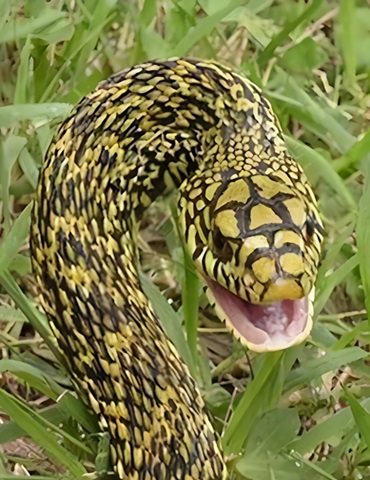The western hognose snake (Heterodon nasicus nasicus), also known as the puff adder, spreading adder, or viper-headed hognose, was once considered a marginal colubrid species. It was often listed in the ‘Miscellaneous’ section of pre-Internet reptile price lists alongside snakes like Thamnophis or Masticophis species. Despite its interesting behaviors, its rather drab appearance limited its appeal among enthusiasts.
In recent years, the western hognose has gained popularity as a pet reptile due to increased awareness of its husbandry needs, wider availability, and the introduction of numerous color, pattern, and genetic mutations. Some enthusiasts believe its popularity may eventually rival that of corn snakes or ball pythons. First classified by French entomologist P. A. Latrielle in the early 19th century and later described by Baird and Girard in 1852, the western hognose is a non-venomous, diurnal, fossorial colubrid with a stout build and a sharply keeled, upturned rostral scale. Adult males typically measure 14 to 22 inches in length and weigh 60 to 120 grams, while females are larger, reaching 20 to 33 inches and 150 to over 350 grams. The snake has keeled scales and uses its enlarged maxillary fangs to seize prey, deflating toads in the process. The dorsal ground color is usually tan, brown, olive, or gray with darker, irregular blotches or bars. Colors can include green, pink, red, orange, and yellow. Some specimens have circular spots in parallel rows. The ventral scales are black with irregular white, yellow, or orange coloration, though some lack this and are entirely black. The western hognose has the widest range of the three Heterodon nasicus subspecies, occurring from southern Saskatchewan and Alberta, Canada, south to Kansas, Oklahoma, and the Texas Panhandle. It inhabits grass plains and sandy soils, feeding on lizards, amphibians, and small mammals.On occasion, H. n. nasiscus also consumes the eggs of turtles and ground-dwelling birds. Interestingly, the species has been known to also consume road carrion.
Famous Faker A western hognose may employ any of several fascinating defensive ploys, or bluffs, to ward off danger when threatened. First, a burst of strong-smelling musk may be expelled from its anal glands to deter an attacker. If this does not do the trick, the snake will often tightly coil the lower part of its body, much like certain varieties of Crotalus, and emit an impressively loud hissing by forcing air through the unique bone structure of its skull and heavily upturned and keeled snout. While in this coiled position, it will also flatten its body, possibly to appear larger to an aggressor, and it will also flatten its neck or “hood” like a cobra. Finally, if all these ploys fail to ward off the danger, a western hognose will roll over onto its back, mouth agape, and feign death. Enclosures for the Western Hog-Nosed Snake A baby western hog-nosed snake may be kept in a relatively small enclosure, such as a small aquarium or a plastic shoebox with adequate ventilation. Aquariums of 20 gallons are ideal, as long as they provide a larger floor area. I house all my animals individually. For my adults, I use sweater boxes in a rack system. Each box measures 28 inches long, 16 inches wide and 6 tall. Babies are housed in plastic Rubbermaid or Sterilite shoeboxes, measuring about 14 inches long, 6 inches wide and 4 inches tall. I prefer simple enclosures for both neonates and adults, with an easily accessible water dish that is not prone to tipping over, a few hides and adequate substrate. For the hides, I often recycle plastic food containers. Anything that makes the snake feel secure and does not have sharp edges can work. For younger hognoses, I recommend a plain newspaper substrate because it is economical, eliminates the potential of substrate ingestion and impaction, and it prohibits the growth of bacteria. For adults, aspen bedding or recycled newspaper products are good, and allow snakes the opportunity to burrow. Heating and lighting are important. Full-spectrum lighting can be used and adjusted to follow seasonal changes. Its use is especially important if you are considering a breeding program. Place heating elements at one end of the enclosure, where a basking spot can be located. All of my heating elements are homemade, but you can purchase lighting from any reptile store or online. The other end of the enclosure should be cooler, allowing a temperature gradient. Air temperature at the warmer end of the enclosure should be around 90 degrees; the cooler end in the high 70s. Western Hog-Nosed Snake Feeding Tips Hatchling western hognoses will usually feed on small, frozen/thawed pinky mice. Moisten a pinky in tap water and, using small forceps, introduce it to a baby snake by nudging the head of the mouse under the snake’s chin. You will find most hatchlings will be curious, and will drink the water off of the mouse.This is a good sign, and normally results in the snake taking the meal. It takes a little practice, so be patient. Some hatchlings, when confronted with food for the first time, will hiss and slither away. Others may roll over and feign death. These behaviors are normal. If they occur, attempt feeding later, after the snake has calmed down.
Some hatchlings may refuse the pinky even after repeated attempts. If this happens, try scenting the pinky with a 1:1 mixture of canned tuna or salmon juice and water. You can have the mixture prepared beforehand; it stores well frozen in a closed container. Some keepers will scent pinkies with toads or frogs, but I don’t recommend this because it will be difficult to get young hognoses off toad-scented items and on to unscented meals, which should be your goal. Offer food weekly or every 10 days. Females that will be bred require food more often – every four to five days. Meal size depends on the size of the snake. Normally, a large female will readily eat a jumbo-sized mouse at each meal, sometimes two. If feeding more than one food item to a snake per meal, consider moving to a larger-sized food item. This also holds true for feeding pinkies to babies. The western hognose is easy to breed. The first thing to consider when undertaking a breeding project is to make sure you have a pair of properly sexed animals. Western hog-nosed snakes are generally easy to sex after their first shed, which occurs a day or so after hatching. The “popping’ method is usually the most accurate method to determine their sex. This is done by gently applying pressure toward the posterior end of the snake’s tail, and rolling the thumb forward toward the cloaca. The presence of hemipenes at either or both sides of the cloacal pouch will indicate a male; their absence indicates a female. Also examine the width and length of the tail; males have longer, more narrow tails, and females’ are shorter and wider at the base. Some breeders probe their babies, but this is not recommended for the western hognose due to the small size of hatchlings. Neonates are normally between 5 to 7 inches long at birth. After determining sex, also consider the age and size of the snakes. Male western hognoses are generally mature and ready to breed at 1 year of age, and should weigh around 70 grams or so (although smaller males have proven to be successful breeders). Females are typically considered mature at 2 years of age, and their weight should be at least 250 grams. Breeding occurs after a period of brumation for both sexes. Prior to brumation, cease feeding the snakes for two weeks to clear their digestive systems. After the two weeks, gradually drop their cage temperatures over the third week from the normal high to a low of 50 to 60 degrees Fahrenheit. A corresponding reduction in the daylight cycle, from the standard 14 to 16 hours per day down to eight hours, is another needed stimulus when considering breeding.Brumation is generally safe for western hognose snakes for two to three months, sometimes longer. Since wild specimens brumate in burrows, light exposure during cooling should be minimal. Inspect snakes and cages weekly to ensure clean water and monitor for drastic weight loss or excessive lethargy. Do not feed during brumation.
After brumation (typically timed for the second week of February), gradually increase cage temperatures and light cycles to normal levels over one week. Once temperatures normalize, offer males food weekly and females twice weekly. Females become receptive to breeding after an ovulatory shed cycle, usually within a month of normal temperatures. When lower body swelling occurs, introduce the male for two to three days or until breeding is visually confirmed at least twice. Gestation lasts 28 to 45 days. Feed females twice weekly during this period, though they may refuse food two weeks before laying eggs. Some females continue taking small meals. A pre-egg-laying shed happens 7 to 12 days before oviposition. Provide a nesting box—a plastic container with damp sphagnum moss, a secure lid, and a hole in the top. The female will become restless and eventually lay eggs in the box. Clutch size varies from 8 to 25+ eggs based on female size, age, and egg size. After laying, move eggs to an incubation container with moistened vermiculite. Punch holes in the container sides, not the lid. Incubate at 78–84 degrees Fahrenheit. Inspect periodically but avoid disturbance. Hatching occurs after 48 to 60 days, depending on temperature. Hognose eggs do not adhere, making them easy to position singly. Bad eggs are misshapen, small, yellow, waxy, or wet. They can be left in place initially but moved to a separate container if needed.It is important to remember to try not to turn the eggs after they have been placed into a container.
Once the neonates begin to emerge from their eggs, it is important not to bother them. They will fully leave their eggs once they have absorbed the yolk. At that time, place all the babies together in a plastic shoebox with adequate ventilation, damp paper towels and a small water dish. They will stay together until after their first shed, when they are ready to be fed and sex can be determined. Western hog-nosed snakes live in areas of relatively low humidity, so it is a good idea to provide more ventilation in areas of higher relative humidity and somewhat less in areas where there is greater aridness. Proper ventilation is made by providing the enclosure with good air flow. Personally, I have found that hognoses do quite well in the southeast United States with high humidity. An indication of too much moisture is the presence of condensation on the walls or container lid. To remedy this, increase the ventilation to keep the enclosure dry. Providing the animal with a smaller, as opposed to larger, water bowl also helps to decrease the humidity. Temperatures and lighting should be at the standard levels, and the babies should shed within a day or so after emerging from the egg. Their first meal can be offered seven to 10 days after they hatch, using the techniques mentioned previously. Exciting Western Hog-Nosed Snake Mutations The increased availability of captive-bred western hognoses has lessened the need to collect wild specimens, although some are occasionally needed to diversify and strengthen existing captive bloodlines. The western hognose is not considered endangered throughout most of its range, but in a few states – such as Colorado, Iowa, Illinois and Missouri – it is protected. As with the collection or purchase of any native reptile, please check your state’s current legislation regarding its status. A steadily increasing number of color and pattern phases and genetic mutations have made the western hognose an exciting species to add to collections. The early 1990s saw the origination of at least three distinct forms of amelanism in the pink pastel albino, albino and T+ albino (then called a hypo). Later, the introduction of the anerythristic gene allowed for breeders to begin work on the double recessive snow, still quite rare in collections, to be followed shortly by a form of ghost combining T+ albino and anerythrism. In the last few years a true form of hypomelanism has been identified, and these hognoses are marketed as a “smoke” morph. There’s also a lavender gene, resulting in a new unrelated type of single recessive snow. Several pattern mutations have opened up a world of possibilities when combined with these genetic mutations. These include the very popular co-dominant anaconda phase, the jungle, spider and others. The next decade will be very exciting to see what new designer morphs are being marketed, as new morphs seem to occur almost every year.Western hognose bites on humans are very rare, and they only occur as a feeding response, not as a sign of aggression. Some western hognoses are aggressive feeders, so it is important to use hemostats when feeding or to leave food items in the cage, allowing them to eat when desired.
Many western hognose bites result in little to no effects, but some bites, probably those of longer duration, do sometimes result in localized swelling that subsides in about a day. The saliva has been identified as a cocktail of protolipase enzymes, which are present in nearly all life forms on earth. While some people experience localized swelling after a bite, there are no known adverse allergic reactions. Many herpetological experts and breeders believe these snakes are harmless. The wide array of colors, patterns, and genetic mutations now available, coupled with the ease of keeping and breeding, makes the western hognose one of the most popular colubrids today. Jeff Clayton is a high school history teacher in Alabama. He has bred snakes for 25 years and has worked extensively with western hognose snakes. He owns a diverse collection of high-quality animals at his private breeding facility. Visit his website at cahabariverreptiles.com, or email him at jclaytonsnakes@yahoo.com.


